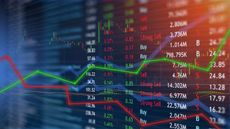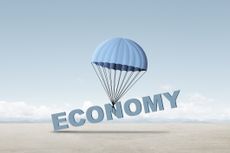Kiplinger Trade Outlook: The Trade Gap Widens Again
Data for May show that trade likely detracted from U.S. GDP growth this spring.

Kiplinger’s Economic Outlooks are written by the staff of our weekly Kiplinger Letter and are unavailable elsewhere. Click here for a free issue of The Kiplinger Letter or to subscribe for the latest trends and forecasts from our highly experienced Kiplinger Letter team.
The trade deficit is at its highest level since late 2022.
The U.S. trade deficit in goods and services rose to a seasonally adjusted $75.1 billion in May, from a downwardly revised $74.5 billion in April. The trade deficit is a measure of the difference between what the U.S. buys from foreign nations and what it sells overseas. The widening in the trade deficit from the previous month came despite both imports and exports falling slightly. The trade deficit has now widened in eight of the past nine months. A resilient U.S. economy and persistent dollar strength are contributing to a wider deficit this year.
Exports fell slightly in May, down 0.8% from the previous month. The decline in exports was driven by a large drop in industrial supplies, specifically petroleum products, fuel oil and gold. However, the decline was broad-based, with modest drops in autos, capital goods and food. Exports of services rose slightly, with travel exports — the spending by visitors to the United States — increasing 4.4% to a new record. Exports have contended with a weaker global economic backdrop and a stronger dollar, which makes U.S. goods relatively more expensive abroad.

Sign up for Kiplinger’s Free E-Newsletters
Profit and prosper with the best of expert advice on investing, taxes, retirement, personal finance and more - straight to your e-mail.
Profit and prosper with the best of expert advice - straight to your e-mail.
Imports are still up year-over-year, as domestic demand continues to normalize. Total imports fell 0.3% in May from the previous month, and while they are not booming, they’re still doing better than exports. Imports are up 6.2% from a year ago, while exports are up 4.3%. Most major categories of imports moved lower in May, but the weakness was concentrated in consumer goods and pharmaceuticals. And even consumer goods imports are still up 5% on a year-ago basis, while continued strong domestic demand remains supportive of growth.
After rising for the first four months of the year, capital goods imports pulled back slightly. Industrial supplies imports bucked the trend in May, rising 2.6% amid a pop in crude oil imports. Imports of services rose to a new record of $67 billion. The trade surplus in services rose to $25.1 billion in May.
Trade will weigh on GDP in the second quarter. May’s data indicate that net exports in the second quarter will be a drag on economic growth. After nearly two years of positive contributions to growth, trade has been a substantial headwind this year. This is primarily due to the continued strength in imports which subtract from net GDP gains.
Source: Department of Commerce, Trade Data
Related content

To continue reading this article
please register for free
This is different from signing in to your print subscription
Why am I seeing this? Find out more here
Get Kiplinger Today newsletter — free
Profit and prosper with the best of Kiplinger's advice on investing, taxes, retirement, personal finance and much more. Delivered daily. Enter your email in the box and click Sign Me Up.

Rodrigo Sermeño covers the financial services, housing, small business, and cryptocurrency industries for The Kiplinger Letter. Before joining Kiplinger in 2014, he worked for several think tanks and non-profit organizations in Washington, D.C., including the New America Foundation, the Streit Council, and the Arca Foundation. Rodrigo graduated from George Mason University with a bachelor's degree in international affairs. He also holds a master's in public policy from George Mason University's Schar School of Policy and Government.
-
 Stock Market Today: Markets Mixed as Rising Rate-Cut Bets Boost Small Caps
Stock Market Today: Markets Mixed as Rising Rate-Cut Bets Boost Small CapsA surprisingly soft inflation report sparked a rotation from mega-caps into riskier names.
By Dan Burrows Published
-
 June CPI Report Comes in Soft: What the Experts Are Saying About Inflation
June CPI Report Comes in Soft: What the Experts Are Saying About InflationCPI Odds rise for a September rate cut after prices fall on a monthly basis for the first time in almost two years.
By Dan Burrows Published
-
 Kiplinger Special: The Long-Term Future of the U.S. Economy
Kiplinger Special: The Long-Term Future of the U.S. EconomyThe Kiplinger Letter Kiplinger's report into what it will take the U.S. to maintain a healthy economic growth rate.
By David Payne Published
-
 The Fight Against Cancer Enters a New Phase
The Fight Against Cancer Enters a New PhaseThe Kiplinger Letter Breakthrough treatments hold promise for patients and investors.
By Matthew Housiaux Published
-
 After Decades of Promise, the Virtual Reality Era Has Finally Arrived
After Decades of Promise, the Virtual Reality Era Has Finally ArrivedThe Kiplinger Letter VR is a paradigm shift for consumer technology. The tech has a long road ahead, but amazing hardware already puts the huge potential on full display.
By John Miley Published
-
 AI to Power the Next Generation of Robots
AI to Power the Next Generation of RobotsThe Kiplinger Letter There's increasing buzz that the tech behind ChatGPT will make future industrial and humanoid robots far more capable.
By John Miley Published
-
 The Robots Are Coming... But Not For a While
The Robots Are Coming... But Not For a WhileThe Kiplinger Letter There’s excitement in the tech sector over the potential of humanoid robots, but widespread adoption is likely to be years away.
By John Miley Published
-
 Farmers Face Another Tough Year As Costs Continue to Climb: The Kiplinger Letter
Farmers Face Another Tough Year As Costs Continue to Climb: The Kiplinger LetterThe Kiplinger Letter Farm income is expected to decline for a second year, while costs continue to up-end farm profitability.
By Matthew Housiaux Published
-
 H-1B Work Visa Rules Get a Revamp
H-1B Work Visa Rules Get a RevampThe Kiplinger Letter H-1B visas allow employers to hire high-skilled foreign workers. Regulators have finalized new rules for this visa program following last fall's proposal.
By Matthew Housiaux Published
-
 Woes Continue for Banking Sector: The Kiplinger Letter
Woes Continue for Banking Sector: The Kiplinger LetterThe Kiplinger Letter Regional bank stocks were hammered recently after news of New York Community Bank’s big fourth-quarter loss.
By Rodrigo Sermeño Published